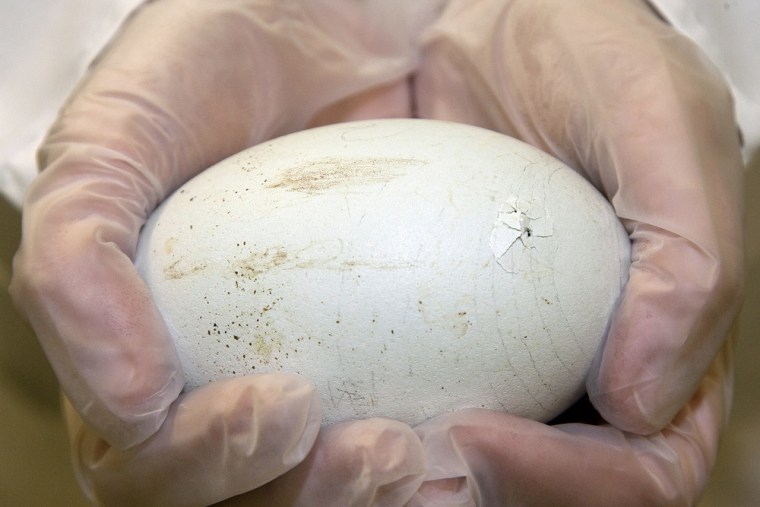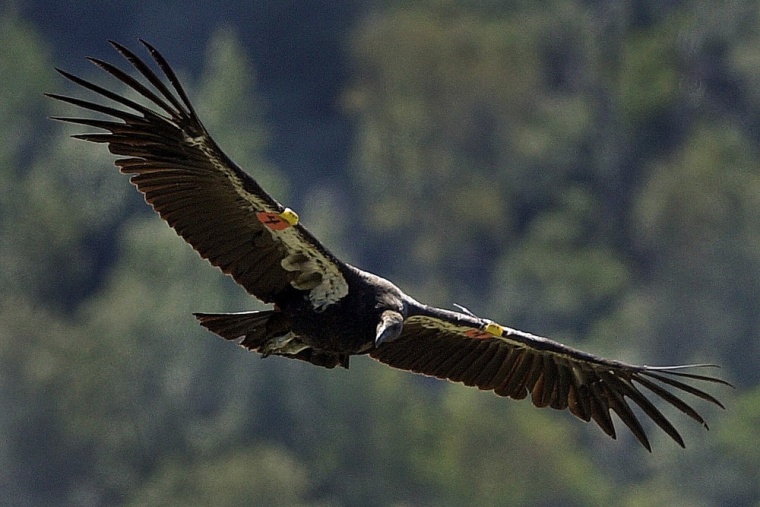One of the most endangered birds in the world, the California condor, has crept back from the brink of extinction through a strenuous three-decade conservation effort. But conservationists say the giant bird can’t become a self-sufficient population in the wild again unless its habitat becomes free of lead ammunition used by hunters.
"It’s huge," said David Shepherdson, deputy conservation division manager at the Oregon Zoo, which has a condor breeding program. "Lead poisoning from lead ammunition is the one thing preventing them from becoming a self-sustaining, non-endangered … wild population."
The California condor is the largest bird in North America, with a wingspan of up to 10 feet. Historically, the species' habitat ranged all the way from Baja, Mexico, to British Columbia, Canada. The mammoth bird, a type of vulture, can fly 150 miles a day.
The population of giant California condors in the wild fell so low in 1982 — 22 birds — that U.S. Fish and Wildlife made the controversial decision to capture them all for breeding programs.
The process has been slow and painstaking. Condors typically lay just one egg every two years in the wild, and even in captivity they rarely have more than one offspring a year. Then, if they survive, they live about the same length of time as humans.
With three decades of work breeding and reintroducing them in the wild, the California condor population had climbed to 405 in an April 30 census — including more than 226 living in the wild, and another 179 living in zoos and four breeding centers, according to a report in The Oregonian, citing U.S. Fish and Wildlife officials.
But for condors, which are scavengers that feed on dead animals and "gut piles" left behind by hunters that contain fragments of lead bullets, lead poisoning is the leading cause of death. The poisoning causes a slow death by starvation or weakens the birds, making them vulnerable to predators.

Condors were first reintroduced to the Vermilion Cliffs near the Arizona-Utah border in 1996 and that wild population now is around 60, flying through the Kaibab National Forest, Grand Canyon National Park and lands in Utah and Nevada.
Of those released in Arizona — one of several reintroduction sites — at least 22 have died of lead poisoning, and many others have required treatment for lead poisoning through a process of "leeching" called kelation, said Kathy Sullivan, a biologist who coordinates the condor program for Arizona Game and Fish.
In California, hunters are barred from using lead ammunition in areas designated condor habitat. The alternative ammunition is often more expensive and harder to find.
Watch US News videos on msnbc.com
On Friday, several environmental groups issued a notice of intent to sue the U.S. Forest Service under the Endangered Species Act for allowing the continued use of lead ammunition in the Kaibab National Forest, a key feeding area for condors released in Arizona.
Banning lead ammunition "isn't like some kind of radical idea," said Sandy Bahr, director for the Grand Canyon Chapter of the Sierra Club, one of the groups threatening to sue. "There has been a requirement for a pretty long time for hunters who are hunting water fowl to use non-lead ammunition. … To get the manufacturers and widespread non-lead ammunition it has to be required.
"(The California condor) is a wonderful comeback story and illustration of how the Endangered Species Act works, and how a concerted effort by many interests can result in giving a species a second chance," said Bahr of the Sierra Club, an environmental lobbying group. "But we can’t just sit back and breathe a sigh of relief."
Officials at Kaibab National Forest did not respond to calls for comment.
But Sullivan, the condor program coordinator for Arizona Game and Fish, said that the state has an effective voluntary program for hunters in Arizona built through education and outreach. Licences for deer hunting and other game are drawn by lottery, and the state actually provides free non-lead ammunition to those whose names are drawn. She said a portion of hunters, instead of changing ammunition, have agreed to remove "gut piles" to prevent lead poisoning of condors. In total, the state has at least 80 percent participation by hunters.
Sullivan said the continuing lead poisoning of Arizona-released condors appears to be because many are now flying into neighboring Utah where there is no such program to limit lead exposure.
"We have a pretty darn successful program in Arizona, but the birds have shifted up to Utah," said Sullivan. "In my opinion that’s where the efforts should be."
More content from msnbc.com and NBC News:
- Analysis: Possible outcomes for John Edwards
- Great-grandma: Ready to 'lose' my life protesting
- US war veterans return medals at NATO protest
- Father of 30, by 11 women, wants state child support
- Marijuana grows openly in California towns, not just for medicinal purposes
- Video: Facebook founder Mark Zuckerberg gets married
Follow US News on msnbc.com on Twitter and Facebook
